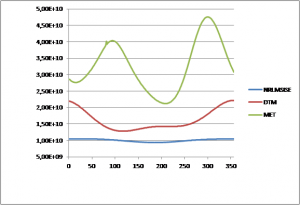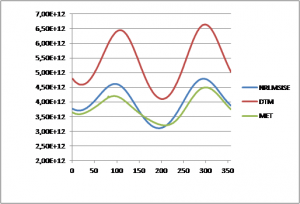Scientific background:
Earth is “breathing”.
The Atmosphere of earth is a dynamic and complex system which changes permanent and depend on different influences.
The most important one is the electromagnetic radiation of the sun which leads to photo dissociation, temperature variations and many other effects.
Other Influences are atmospheric tide effects, geomagnetism and up to now not cleared up variations.
Depending on wavelength (320 nm < λ < 1180 nm) ozone reacts to molecular and atomic. Because of the temperature variation and the gravitational field atomic oxygen diffuse to a higher altitude and recombine again when the radiation relieving Then the oxygen fall down again.
Due to the reduction of molecular oxygen and the diffusion of the atomic oxygen, in the altitude of 450 km atomic oxygen comes about 90 percent.
So the daily and annual variation of the sun radiation on a certain place on earth leads to significant changes of chemical composition in the atmosphere.
Atmospheric models were developed to predict densities, temperature and pressure in different altitudes for different longitudes and latitudes.
These models differ on the theoretical assumption, used data sources and needed input parameter.
Atmospheric models
NRLMSISE-00:
MSIS (Mass Spectrometer and Incoherent Scatter) is an empiric model that is based on mass spectrometer data and pressure measurements of rockets, satellites and airplanes as well as on temperature measurements of incoherent scatter radars.
By addition of new data and combination with physical models the MSIS model has been developed to the NRLMSISE-00 (Naval Research Laboratory Mass Spectrometer and Incoherent Scatter) model. It predicts from sea level to the exosphere.
DTM:
The DTM model (Drag Temperature model) uses optical temperature measurements and data of atmospheric drag from satellites. It works with the assumption that helium, nitrogen and oxygen are the essential elements of the atmosphere from 120 km to higher altitude and connect them with diffusion equations.
MET-2.0:
The MET model (Marshall Engineering Thermosphere Model) has edge condition of temperature and gas composition of 90km and based on diffusion equations and temperature assumptions to the altitude where data from satellite retardation exist.
Prediction of atomic and molecular oxygen
We calculated a prediction of atomic and molecular oxygen to an altitude of 340 km for longitude and latitude of 0 degree for the year 2012, based on these three models. We used SPENVIS (ESA, European Space Agency, Space Environment Information System) for the calculation and the input parameters from the NOAA database.


In the prediction of molecular Oxygen the MET model shows a strong influence of the seasons.
The DTM model predicts a higher density for the beginning and end of the year and the in NRLMSISE model are no significant variations visible.
The values differ a lot from day to day.
In the prediction of atomic oxygen every model shows a clear influence of the seasons.
This comparison shows that these models are insufficient for a clear prediction. It is necessary to take time-resolved measurements of the densities of the gases in the atmosphere. That is a reason why these sensors have been developed.
The aim is to correlate one model or prospect up to now unknown influences and create a new model for calculating a precise prediction.